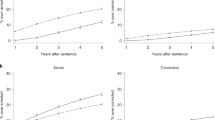Abstract
Using official data, 331 boot camp participants and a stratified random sample of 369 regular probationers were tracked for rearrests over a threeyear period. Chisquare tests and logistic regression analysis indicate that participation in boot camp was significantly associated with rearrest for drug offenses, offenses categorized as “other,” and all types of offenses combined. Contrary to most prior research, which suggests that boot camp participation has no effect on subsequent criminal behavior, the results in this study indicate that participation in the boot camp program had a detrimental effect on its participants.
Similar content being viewed by others
References
American Correctional Association. (1983).The American prison: From the beginning. Laurel, MD: Author.
Bodapati, M. R., Jones, M., & Marquait, J. W. (1995). The sentencing practices of judges and juries: A comparative analysis using Texas drug offenders.Journal of Crime and Justice, 18, 181–203.
Burns, J. C., & Vito, G. F. (1995). An impact analysis of the Alabama boot camp program.Federal Probation, 59, 63–67.
Burton, V. S., Marquait, J. W., Cuvelier, S., Alarid, L. F., & Hunter, R. J. (1993). A study of attitudinal change among boot camp participants.Federal Probation, 57, 46–52.
Byrne, J. M. & Pattavina, A. (1992). The effectiveness issue: Assessing what works in the adult community corrections system. In J. M. Byrne, A. J. Lurigio, & J. Petersilia (Eds.),Smart sentencing: The emergence of intermediate sanctions (pp. 281–303). Newbury Park, CA: Sage Publications.
Geerken, M. R., & Hayes, H. D. (1993). Probation and parole: Public risks and the future of incarceration alternatives.Criminology, 31, 549–564.
Hunter, R. J. (1994, July, August). A locally operated boot camp: Harris County (Houston), Texas.American Jails, 12–15.
Jones, M. (1996). Do boot camp graduates make better probationers?Journal of Crime and Justice, 19, 1–14.
MacKenzie, D. L. (1991). The parole performance of offenders released from shock incarceration: A survival time analysis.Journal of Quantitative Criminology, 7, 213–236.
MacKenzie, D. L. (1994). Results of a multisite study of boot camp prisons.Federal Probation, 58, 60–66.
MacKenzie, D. L., & Shaw, J. (1993). The impact of shock incarceration on technical violations and new criminal activities.Justice Quarterly, 10, 463–488.
MacKenzie, D. L., & Souryal, C. (1995). Inmates’ attitude change during incarceration: A comparison of boot camp and traditional prison.Justice Quarterly, 12, 325–354.
Maguire, K., & Pastore, A. L. (Eds.). (1995).Sourcebook of Criminal Justice Statistics 1994. Washington, DC: US Department of Justice.
McCorkle, R. C. (1995). Correctional boot camps and attitudinal change: Is all this shouting necessary?Justice Quarterly, 12, 365–376.
Mcgaha, J., Fichter, M., & Hirschburg, P. (1987). Felony probation: A reexamination of public risk.American Journal of Criminal Justice, 11, 1–9.
Parent, D. G., Chaiken, M., & Logan, W. (1989).Shock incarceration: An overview of existing programs. Washington, DC: National Institute of Justice.
Pearce, S. C., & Madler, J. H. (1995). Compendium of community corrections programs in North Carolina fiscal year 1993–94. Unpublished document.
Petersilia, J., Turner, S., Kahan, J., & Peterson, J. (1985).Granting felons probation: Public risks and alternatives. Santa Monica, CA: RAND Corp.
Rogers, R., & Jolin, A. (1989). Electronic Monitoring: A review of the empirical literature.Journal of Contemporary Criminal Justice, 5, 141–152.
Rothman, D. J. (1971).The discovery of the asylum: Social order and disorder in the new republic. Boston: Little, Brown.
Spader, D. J. (1991). Individual rights vs. social utility: The search for the golden zigzag between conflicting fundamental values. In M. C. Braswell, B. R. McCarthy, & B. J. McCarthy (Eds.),Justice, Crime and Ethics, (pp. 25–50). Cincinnati: Anderson Publishing.
State Bureau of Investigation. (1995).Crime in North Carolina 1994: Uniform crime report. Raleigh, NC: North Carolina Department of Justice.
Vito, G. F. (1987). Felony probation and recidivism: Replication and response.Federal Probation, 50, 17–25.
Walker, S. (1994).Sense and nonsense about crime and drugs: A policy guide (3rd ed.). Belmont, CA: Wadsworth Publishing.
Author information
Authors and Affiliations
Rights and permissions
About this article
Cite this article
Jones, M., Ross, D.L. Is less better?: Boot camp, regular probation and rearrest in North Carolina. Am J Crim Just 21, 147–161 (1997). https://doi.org/10.1007/BF02887447
Issue Date:
DOI: https://doi.org/10.1007/BF02887447




